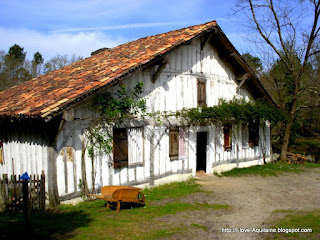Peaceful sheep at the Marquèze Ecomusée.
I'm not a history fanatic, but sometimes knowing a bit of the history for a place helps to understand what you see here and now. As of today, it is difficult to imagine Landes without the big pine forest, the biggest planted forest in Europe, but in the beginning of the 18th century most of the region was covered by vast heaths and marshlands. Fifty years later started the changes that would lead to the enormous planted pine forest of today. Let’s have a look at life in those days, just before the big changes.
The villages were small. A church, a mayor and a few artisans, that was all. Most of life was centered to the farms who were almost totally self sufficient. The basic principles were simple. You needed to have enough sheep to get enough manure to get enough nutrition for the poor soils to grow enough barley and wheat to get enough bread to feed the inhabitants of the farm in bread. At that time, a person was estimated to need around 1 kg of bread per day – the equivalent of four baguettes. They had bread and vegetable soup in the week, porridge in the evening and meat almost only on Sundays.
Impressive oaks in what is called the Airial, the area around the farm.
Picture from approx. 1950, so here you already see some pine forest. This is a typical symbol for Landes, the shepherd on his stilts.
I visited the Marquèze Ecomusée with the children in May last year. To get out to the farm you have to start with a short train ride. We started by looking at the mill and saying hello to the black pig Papillon. They we joined a very interesting guided tour, looked at the different houses, the tools and learned about life back then. We ended the visit with the sheep that are kept freely within the farm area, to keep the grass short and nice.









Did your kids like it?
ReplyDeleteI went there as a kid, and I actually hated it, I was bored to death.
But now, I really want to go back as an adult, because I know I missed something interesting and instructive (mmm... something I could do this summer when I move back to the South West)
Oh, trop de bons souvenirs resurgissent. Je l'avais visité avec mes parents quand j'avais 13-14 ans et je m'en rapelle encore. Il va falloir que j'y revienne avec mes enfants.
ReplyDeleteHi David! My children loved the train! They also love animals, so the little baby ducks, the big pig and the sheep were great too.... The guided tour was rather boring to them, but ok since it didn't last too long.
ReplyDeleteMaybe you were in the wrong age when you came, not young enough, not old enough?!
Yeah, I was really young, about 8 or 9. But I'm sure I'd enjoy it now.
ReplyDeleteJag tycker också det är spännande att veta något om en plats historia. Det gör ju att man på ett annat sätt förstår varför det ser ut på ett visst sätt eller varför människor beter sig som de gör.
ReplyDelete